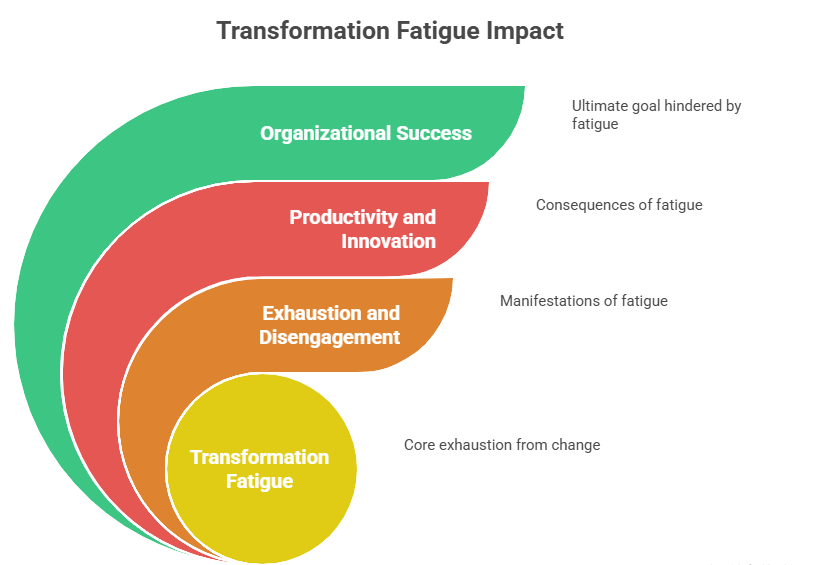Why Transformation Fatigue is Real (and What Leaders Can Do About It)
The Reality of Transformation Fatigue
Transformation fatigue, also known as change saturation, is a state of exhaustion and resistance that employees experience when subjected to too many organizational changes in a short period. This document explores the causes and consequences of transformation fatigue, emphasizing its impact on employee morale and productivity. Furthermore, it provides actionable strategies for leaders to build sustainable, human-centered change initiatives that minimize fatigue and maximize positive outcomes.

Today, organizations are constantly striving to adapt and improve. This often translates into a series of transformations, from implementing new technologies and processes to restructuring teams and redefining roles.
While change is essential for growth and competitiveness, an excessive or poorly managed change can lead to transformation fatigue.
Transformation fatigue is not merely a case of employees disliking change. It's a deeper phenomenon rooted in the psychological and emotional toll that constant adaptation takes on individuals.
When employees are bombarded with changes, they may experience:
Increased Stress and Anxiety: Uncertainty about the future, job security, and their ability to adapt can lead to heightened stress levels.
Decreased Motivation and Engagement: Constant change can make employees feel like their efforts are futile, leading to a decline in motivation and engagement.
Reduced Productivity and Performance: Fatigue and stress impair cognitive function, making it difficult for employees to focus and perform their jobs effectively.
Cynicism and Resistance: Over time, employees may become cynical about change initiatives, viewing them as disruptive and ultimately ineffective.
Burnout: The cumulative effect of constant change can lead to burnout, characterized by emotional exhaustion, depersonalization, and a sense of reduced accomplishment.
Causes of Transformation Fatigue

Several factors contribute to the development of transformation fatigue:
Too Much Change, Too Soon: Implementing multiple changes simultaneously or in rapid succession overwhelms employees and leaves them feeling like they can't keep up.
Lack of Communication and Transparency: When changes are poorly communicated or shrouded in secrecy, employees feel uninformed and uncertain, fueling anxiety and resistance.
Insufficient Training and Support: Employees need adequate training and support to adapt to new processes, technologies, and roles. Without it, they may feel overwhelmed and incompetent.
Lack of Employee Involvement: When employees are not involved in the change process, they may feel like their voices are not heard and that changes are being imposed upon them.
Inconsistent Leadership: If leaders are not aligned in their support for change initiatives or if they send mixed messages, employees may become confused and distrustful.
Ignoring the Human Element: Focusing solely on the technical or strategic aspects of change while neglecting the emotional and psychological impact on employees is a recipe for fatigue.
Past Negative Experiences: Previous failed or poorly managed change initiatives can create a sense of skepticism and resistance among employees.
Building Sustainable, Human-Centered Change

To mitigate transformation fatigue and foster a culture of sustainable change, leaders must adopt a human-centered approach that prioritizes employee well-being and engagement. Here are some key strategies:
Prioritize and Sequence Changes: Avoid implementing too many changes at once. Carefully prioritize initiatives based on their strategic importance and potential impact on employees. Sequence changes in a way that allows employees to adapt and integrate them effectively.
Communicate Clearly and Transparently: Keep employees informed about the reasons for change, the expected outcomes, and the timeline for implementation. Be honest and transparent about the challenges and potential risks. Use multiple communication channels to reach all employees and provide opportunities for feedback and questions.
Involve Employees in the Change Process: Engage employees in the planning and implementation of change initiatives. Solicit their input, ideas, and concerns. Empower them to take ownership of the change process and contribute to its success.
Provide Adequate Training and Support: Ensure that employees have the knowledge, skills, and resources they need to adapt to new processes, technologies, and roles. Provide comprehensive training programs, mentoring opportunities, and ongoing support.
Address Employee Concerns and Anxieties: Acknowledge and address employee concerns and anxieties about change. Create a safe space for them to express their feelings and provide reassurance and support.
Celebrate Successes and Recognize Contributions: Recognize and celebrate successes along the way. Acknowledge and appreciate the efforts of employees who are contributing to the change process.
Lead by Example: Leaders must demonstrate their commitment to change by actively participating in the process and modeling the desired behaviors.
Monitor and Evaluate the Impact of Change: Continuously monitor and evaluate the impact of change initiatives on employee morale, productivity, and well-being. Use feedback from employees to make adjustments and improvements.
Build Resilience: Help employees develop resilience by providing them with tools and resources to manage stress, cope with uncertainty, and adapt to change.
Focus on Purpose and Meaning: Connect change initiatives to a larger purpose or mission that resonates with employees. Help them understand how their work contributes to the overall goals of the organization.
Conclusion
Transformation fatigue is a real and significant challenge for organizations in today's dynamic business environment.
By understanding the causes and consequences of transformation fatigue and adopting a human-centered approach to change management, leaders can minimize its negative impact and build a culture of sustainable change that benefits both the organization and its employees.
The key is to prioritize employee well-being, communicate effectively, involve employees in the process, and provide the necessary support and resources to navigate change successfully.

